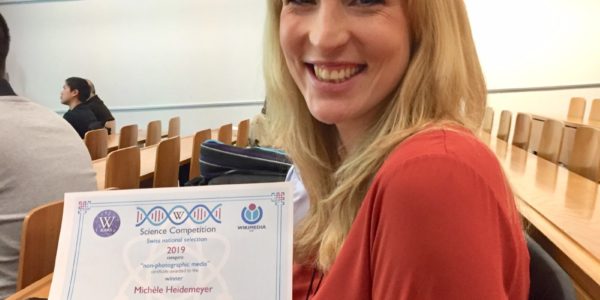The winner in the “non photographic media” category for Wiki Science Competition 2019 is Michèle Heidemeyer. During her school days, as she says “I was aware that chemistry was always something strenuous and complicated for my classmates, but for me it was logical and predictable. It was then that I realized that scientific connections interested me and that I would like to go deeper into the matter.”
The practical training as a chemical technical assistant allowed her to combine scientific background knowledge with practical work. She got a job as a Research Technician at the ETH Zürich, where she was surrounded by young motivated researchers, academics and lots of biological questions. During five years at ETH she focused on how microRNAs can influence diabetes type 2. Afterward, she changed the subject from pancreas to kidney focusing on the sodium chloride co-transporter function (Ravarotto V. & at Hypertens Res. 2018 Aug;41(8):578-588 https://www.ncbi.nlm.nih.gov/pubmed/29925901 ).
In 2018 “I had a baby and a part-time job was not more possible at ETH. Therefore, looking outside the academic walls, I found Axonlab, where family life and career could be combined smoothly”. She still have close contact with the academia helping customers to find solutions for their research though technical support and also through her work on the company’s scientific magazine. She is a gifted copywriter and she came across the Wiki Science Competition for her reports during research for a blogpost for their website.
As Inside Sales Manager of the Life Science Department of Axonlab, Michèle Heidemeyer takes quality assurance tasks, tests of devices and, as a trained laboratory technician, she carries out tests on the Azure Sapphire. The image of the watermelon is therefore a product of a quality test and shows the beauty of an otherwise rather unspectacular fruit.
As discussed, Axonlab confirmed they will donate the prize money received to the Foundations Simplysience.ch.
Image of winner: Cucumnis melo in excellent sensitivity CC BY-SA 4.0 Axonlab (Michèle Heidemeyer) 2019 Wikimedia Commons
The runner-up is Kevin Floc’h. He obtained an Engineering degree at Grenoble-INP Phelma and later worked as a Ph.D. student at the Institut de Biologie Structurale in Grenoble. He worked on the nucleoid dynamics and in-depth characterization of Deinococcus radiodurans cell cycle using advanced fluorescence microscopy (super-resolution fluorescence microscopy and spinning-disk confocal microscopy). He is now a Marketing Associate in Rare Diseases & Endocrinology at Sanofi in Zug.
Kevin ended in the 2nd place of the “Non-photographic media” category with a video, which summarizes parts of his Ph.D. results, into a popular scientific medium.
Many videos and animations exist of eukaryotic cells (like human cells), going through their division cycle, where chromosomes undergo a precise “choreography” (for example, replicated chromosomes separating into the two new daughter cells). Unlike in eukaryotic cells, in bacteria such precise “choreography” of their whole chromosomes has not been observed. Kevin’s video actually depicts the discovery of such peculiar chromosomes dynamics in a bacterium, Deinococcus radiodurans, known for being one of the most radiation-resistant organisms. The video is a reconstitution of the 6 different phases, of the changes in cell shape (in red) and the chromosomes (in green), during the cell cycle of Deinococcus radiodurans.
More details can be found in the following publication: Floc’h, Kevin et al. „Cell morphology and nucleoid dynamics in dividing Deinococcus radiodurans.“ Nature communications 10.1 (2019): 1-13.
Video of runner-up CC BY-SA 4.0 Kevin Floc’h 2019 Wikimedia Commons
Portrait Michèle Heidemeyer: Wikimedia CH




